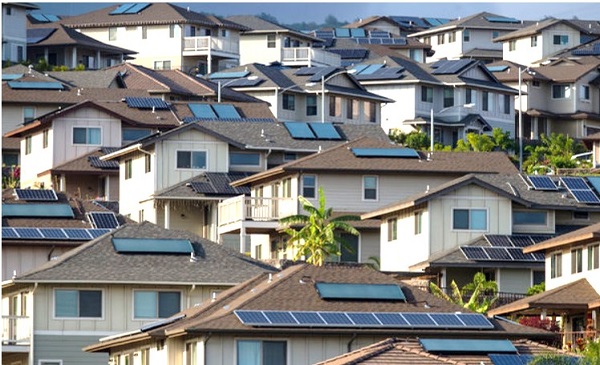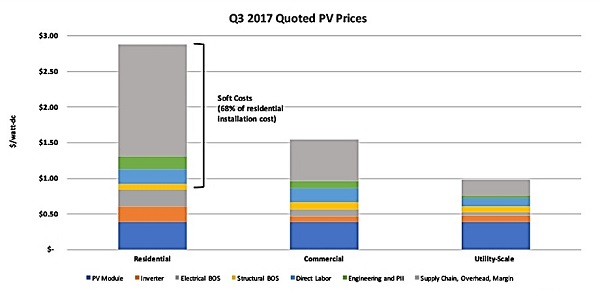The press has been abuzz this summer about the California Energy Commission’s (CEC) new building code amendment that will require most single-family residential and low-rise multi-family dwellings to incorporate PV systems at construction. The amendment takes effect in 2020. Buildings located where solar will not perform well will be exempt, but the typical California neighborhood of the future may look something like the Hawaiian one pictured below.

Criticism of the amendment has come from several places, including the Haas Energy Institute at UC Berkeley. One concern offered by critics is that residential PV is not cost-effective compared with central station solar. Another concern is the ramping and storage issues surrounding solar, such as the “duck curve.” These are important, but were adequately considered by the CEC.
California is again unambiguously ahead of the curve on this front, but it isn’t the “first state” this time. Hawaii mandated solar water heating on single-family homes more than a decade ago. It has worked out well, and to my surprise, some builders installed PV-to-electric water heaters in order to meet the standard, instead of installing traditional solar-thermal water heaters. PV has gotten that cheap.
Today, the average Hawaii residential consumer uses about 15 percent less grid-supplied electricity than a decade ago, and a significant portion of the decline is due to solar, both water heat and PV. In Hawaii, where electricity is expensive, this has been a significant benefit to occupants of new homes.
The duck curve challenges in California—and Hawaii—are very real, but both states are taking steps consistent with the ten strategies we presented in Teaching the Duck to Fly. These include time-varying rates, targeted energy efficiency, pursuit of peak-oriented renewables, ice-storage air conditioning and grid-integrated water heating, and other effective measures.
I too was initially skeptical of California’s blanket mandate. But California’s notion that “making it code” will turn rooftop PV into a lower-cost commodity has certainly been true for other mandated technologies, such as high-performance glazing, heat pump water heaters, and high-efficiency refrigerators.
One recent news story on the CEC action stated, “For residential homeowners, based on a 30-year mortgage, the Energy Commission estimates that the standards will add about $40 to an average monthly payment, but save consumers $80 on monthly heating, cooling and lighting bills.” Many readers of this post would want to see a long-run marginal cost analysis, not a retail bill analysis, but its 2:1 benefit:cost ratio for the consumer makes it attractive, not a penalty, so I would approach that analysis with some confidence.
And CEC has explicitly called out one of the biggest benefits of rooftop PV: its shading effect that reduces air-conditioning loads. One study from San Diego showed that for every kWh generated by a PV system, consumers saved another 0.3 kWh in air conditioning usage. Another, from Arizona, showed an 11 percent reduction in electricity costs, taking in to account both reduced AC load and increased heating load. Taking reserves, marginal line losses, and distribution capacity costs into account, this is a big boost to PV cost-effectiveness that most analysts ignore.
Solar prices have indeed come down sharply, but the prices for small-scale residential installations remain higher than those of large-scale systems. However, residential systems have other advantages over central-system solar. They include avoided transmission and distribution costs, avoided distribution losses, and reduced air-conditioning requirements due to roof shading. The CEC considered all of these factors.
The graphic below shows a recent comparison of PV system costs. Residential rooftop systems cost about three times as much as large utility-scale systems. If Xcel Energy’s recent bids (and those received by utilities from Mexico to India to the United Arab Emirates) are representative, this means 3 cents per kWh for utility-scale systems compared with about 9 cents per kWh for small rooftop systems. But one stated goal of the CEC is to make rooftop solar a “commodity” to reduce the “soft costs” of installation. With a mandate, for example, “customer acquisition” costs drop to zero. If the installed residential PV system drops to about 6 cents per kWh with a combination of cost reduction and financing through low-cost mortgages, the societal cost-effectiveness will be pretty solid.

Source: GTM Research and Solar Energy Industries Association
By making solar a code element, subdivision builders will simply treat it as one more subcontractor task, along with plumbing, electric, roofing, framing, drywall, and painting. And the majority of the “supply chain, overhead, and margin” cost—fully one-half of current small-scale solar costs—would shrink to resemble the utility cost stack.
Before one criticizes California’s decision here, one should consider the results of past policies. For instance, let’s compare two states with very different approaches: Georgia and California. Georgia has lower electric rates. California has lower electric bills.
First there are a few caveats regarding this comparison: It uses 2015 income data but 2016 electric bill data; the picture would be more full with an analysis of natural gas rates, too; and housing stock and climate adjustment might be appropriate (though Georgia’s coal-heavy electricity mix contributes more to that climate adjustment). But overall, while California’s residential electric rates are much higher than those in Georgia—17.4 cents per kWh average vs. 11.5 cents per kWh—California’s average electricity bills are lower than those in Georgia.
Georgia has chosen the low-regulation, high-supply approach to energy. Weak energy codes, no appliance standards, few utility incentive or rebate programs, and electric rate design with relatively high fixed charges and low per-kWh charges.
California has chosen a high-regulation, high-efficiency approach, with lots of appliance and building standards, lots of utility incentive and rebate programs, and electric rate design that encourages efficiency and frugality. Now they’ve added another building standard: integrated PV.
The bottom line is illustrated in the table below. The electricity burden in California is much lower than in Georgia, despite the RPS, EE programs, rate design, and other California policies that have drawn the ire of some. In fact, it is not despite these policies that Californians enjoy lower electricity bills than Georgians, it’s because of them.
Comparison of California and Georgia Electricity Bill Burdens
| California | Georgia | |
| Average monthly electric bill | $95.20 | $130.87 |
| Average monthly household income | $5,375 | $4,270 |
| % of income going to pay for electricity | 1.8% | 3.1% |
Sources: https://www.eia.gov/electricity/sales_revenue_price/pdf/table5_a.pdf
https://en.wikipedia.org/wiki/List_of_U.S._states_by_income
California’s past efficiency and rate policies—including the California Alternate Rates for Energy (CARE), a very generous assistance program for low-income households—have kept electric bills manageable for nearly all households. That’s an impressive achievement in a high-cost business environment like California’s, with expensive real estate, labor, taxes, and transportation congestion costs.
The bottom line: California is again ahead of the curve in mandating PV systems in new homes. The experience of Hawaii’s solar water heat mandate shows that a code requirement dramatically reduces costs of the measure over a very short period of time. At lower costs, residential PV will likely be quite cost-effective, countering the critics’ argument that it’s too pricey compared with utility-scale options. And as our state comparison shows, California’s aggressive energy efficiency policies of the past three decades are clearly paying big benefits to the state’s electric consumers. Its rooftop PV requirement will be no different.
